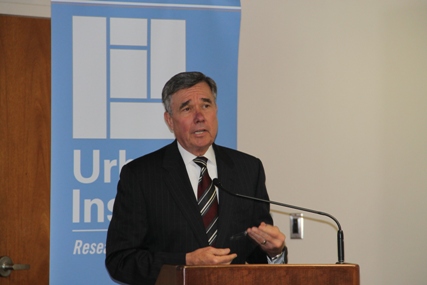
- R. Gil Kerlikowske, Director, National Drug Control Policy / Photo by Lisa Pilnik
Early in his tenure as director of the White House Office of National Drug Control Policy, R. Gil Kerlikowske told a reporter he no longer wanted to use the term “war on drugs” to describe drug control policy. When asked what “bumper sticker” phrase he would use as a replacement, Kerlikowske responded that he thought the American public was “ready for a greater dialogue and discussion about our drug problem than a bumper sticker answer.”
Kerlikowske shared this anecdote at a forum on 21st Century Drug Policy Reform hosted by the Urban Institute, where he and other speakers emphasized prevention and treatment of substance abuse. “We have to approach drug policy from a public health standpoint, not just the criminal justice standpoint,” said Kerlikowske, emphasizing that programs and policies should be based on a foundation of science. He added that although his office has advocated this approach for four years, he’s only seen it begin to take hold in the past six months.
Kerlikowske cited numerous statistics on the pervasiveness of drug addiction, such as findings from the national Arrestee Drug Abuse Monitoring Program (ADAM II) that showed -- in the five participating sites -- more than half of adult male arrestees tested positive for illegal drugs. He also referenced a California study showing that inmates who participated in drug treatment in prison and completed an after care program were half as likely to return to prison. Kerlikowske, who was formerly the Chief of Police for Seattle, Wash., said that although law enforcement plays an important role in addressing violent drug-related crime, he and his colleagues across the country “know we aren’t going to arrest our way out of this problem.”
Re-entry services for offenders are also vital. Kerlikowske said “if you don’t spend the time, and frankly if you don’t spend the money to help them reintegrate… [it’s no surprise] that people would re-cycle back through the system.”
He also lauded veterans’ courts, drug courts, and other alternatives to incarceration, saying “if you’ve…been to a drug court and seen what your taxpayer dollars can do and you’re not moved…you’ve probably got a heart of stone.”
Kerlikowske closed his formal remarks by discussing drug addiction’s impact on young people, saying that “we must also keep that very protective eye on this next generation, the young people who are …going to be the leaders and the innovators of this country.” He explained that drug use inhibits young people’s ability to achieve their full potential and said “we owe our youth our full and steadfast support” and must “prevent drug use from limiting our children and our nation’s future.”
The forum also included a panel discussion of marijuana use, prescription drug abuse, and synthetic drugs, as well as discussion of substance addiction’s disproportionate impact on minorities.
Panelist Thomas Manger, chief of police for Montgomery County, Md., spoke out against legalization of marijuana but also supported decriminalization of drugs in some circumstances. Manger said that his county’s School Resource Officers find marijuana in students’ lockers every day, and while they are “horrified” by the impacts of marijuana on kids, none think that the solution is to charge them criminally.
Speaking to JJIE after the event, panel moderator Nancy LaVigne, director of the Justice Policy Center at the Urban Institute, said that the forum’s focus on prevention and treatment of drug addiction is essential for youth in the juvenile justice system. “It’s critical that we focus on youth who are engaging in substance abuse or are in danger of doing so,” said LaVigne, noting that “the best approaches are comprehensive, involving schools, youth, and other community entities” and focusing on early intervention and community awareness.
LaVigne also said that drug policies affect children who are not substance users themselves, adding, “what we heard from Director Kerlikowske is that the Administration is looking at programs that offer treatment and divert offenders from prison. That can impact kids at multiple levels.” Many drug-addicted adults involved with the justice system are parents of children, she explained, and incarceration removes them from their children’s lives. That often removes the breadwinner from the family, while not usually offering any formal treatment. Treatment and other alternatives, like drug courts, can help preserve family relationships, said LaVigne.
Lisa Pilnik, JD, MS, is a freelance writer, consultant, and co-founder of Child & Family Policy Associates, a Maryland-based consulting firm.

